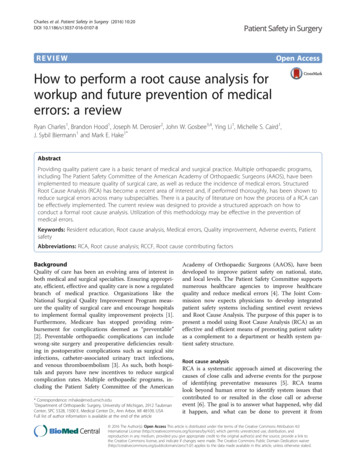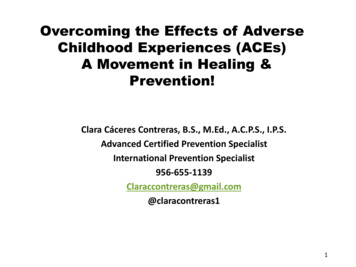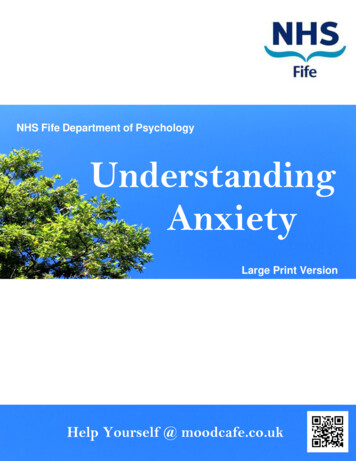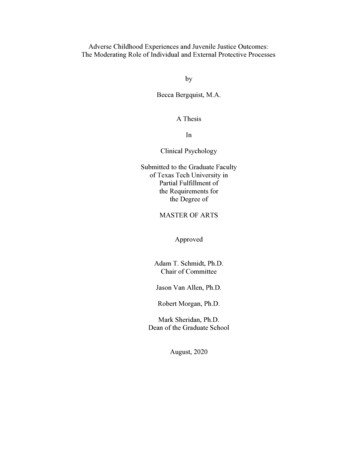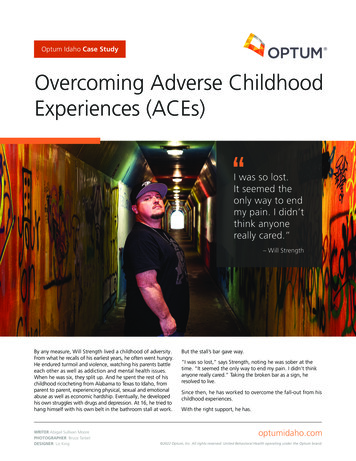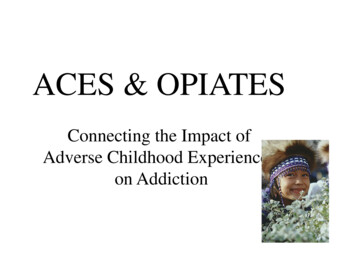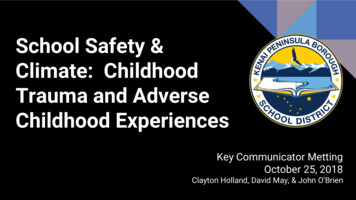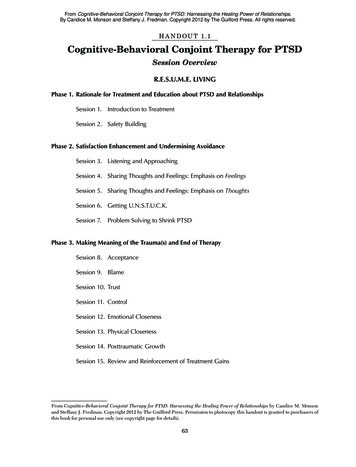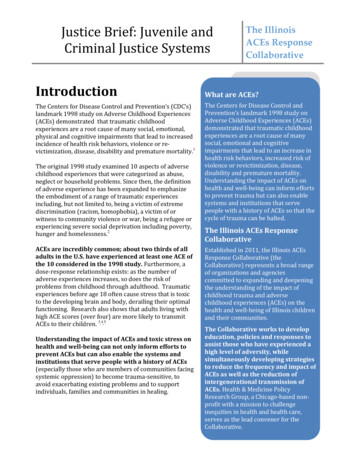
Transcription
Justice Brief: Juvenile andCriminal Justice SystemsIntroductionThe Centers for Disease Control and Prevention’s (CDC’s)landmark 1998 study on Adverse Childhood Experiences(ACEs) demonstrated that traumatic childhoodexperiences are a root cause of many social, emotional,physical and cognitive impairments that lead to increasedincidence of health risk behaviors, violence or revictimization, disease, disability and premature mortality.1The original 1998 study examined 10 aspects of adversechildhood experiences that were categorized as abuse,neglect or household problems. Since then, the definitionof adverse experience has been expanded to emphasizethe embodiment of a range of traumatic experiencesincluding, but not limited to, being a victim of extremediscrimination (racism, homophobia), a victim of orwitness to community violence or war, being a refugee orexperiencing severe social deprivation including poverty,hunger and homelessness.2ACEs are incredibly common; about two thirds of alladults in the U.S. have experienced at least one ACE ofthe 10 considered in the 1998 study. Furthermore, adose-response relationship exists: as the number ofadverse experiences increases, so does the risk ofproblems from childhood through adulthood. Traumaticexperiences before age 18 often cause stress that is toxicto the developing brain and body, derailing their optimalfunctioning. Research also shows that adults living withhigh ACE scores (over four) are more likely to transmitACEs to their children. 3,4,5Understanding the impact of ACEs and toxic stress onhealth and well-being can not only inform efforts toprevent ACEs but can also enable the systems andinstitutions that serve people with a history of ACEs(especially those who are members of communities facingsystemic oppression) to become trauma-sensitive, toavoid exacerbating existing problems and to supportindividuals, families and communities in healing.The IllinoisACEs ResponseCollaborativeWhat are ACEs?The Centers for Disease Control andPrevention’s landmark 1998 study onAdverse Childhood Experiences (ACEs)demonstrated that traumatic childhoodexperiences are a root cause of manysocial, emotional and cognitiveimpairments that lead to an increase inhealth risk behaviors, increased risk ofviolence or revictimization, disease,disability and premature mortality.Understanding the impact of ACEs onhealth and well-being can inform effortsto prevent trauma but can also enablesystems and institutions that servepeople with a history of ACEs so that thecycle of trauma can be halted.The Illinois ACEs ResponseCollaborativeEstablished in 2011, the Illinois ACEsResponse Collaborative (theCollaborative) represents a broad rangeof organizations and agenciescommitted to expanding and deepeningthe understanding of the impact ofchildhood trauma and adversechildhood experiences (ACEs) on thehealth and well-being of Illinois childrenand their communities.The Collaborative works to developeducation, policies and responses toassist those who have experienced ahigh level of adversity, whilesimultaneously developing strategiesto reduce the frequency and impact ofACEs as well as the reduction ofintergenerational transmission ofACEs. Health & Medicine PolicyResearch Group, a Chicago-based nonprofit with a mission to challengeinequities in health and health care,serves as the lead convener for theCollaborative.
The Impact of ACEs on the Juvenile andCriminal Justice SystemsACEs are the root cause of many of society’s most pressing health problems that contribute to the astronomicaland rising costs of health care as well as tremendous social costs in morbidity, mortality and quality of life. AnACE score greater than or equal to six can shorten an individual’s lifespan by as much as 20 years.If we want to break the cycles of juvenile and criminal justice system involvement, improve public safety andprotect crime victims and community well-being, we have to recognize the implications of ACEs and adoptpolicies and practices that recognize and respond to trauma, while also preventing its occurrence. This briefprovides an overview of the relationship between childhood trauma and involvement with the juvenile andcriminal justice systems, describes the need for better prevention and intervention efforts, and offers a numberof policy recommendations and resources to assist actors across these systems in adopting trauma-informedpractices that can break the cycles of involvement.The Ripple Effect of ACEs Across the Juvenile and Criminal Justice SystemsSources: Julian D. Ford, John F. Chapman, Josephine Hawke & David Albert, Trauma Among Youth in the Juvenile Justice System: CriticalIssues and New Directions, National Center for Mental Health and Juvenile Justice: Research and Program Brief (June 2007); The Trajectoryof a Traumatized Youth, Robert F. Kennedy Children’s Action Corps (2016).PrevalenceAs depicted above, experiencing traumatic events or ACEs can result in behaviors that lead toinvolvement with the juvenile and criminal justice systems, starting a cycle of consequences that impactpeople throughout their lives and affect the next generation. For some children and adults, involvementin these systems is a source of trauma or retraumatization in and of itself. Such experiences lead toincreased unemployment, poverty, homelessness and further involvement with the criminal justice2
system. Because experiencing poverty and parental incarceration is a form of trauma as well, the impactcarries to the next generation.The prevalence of this cycle is evidenced by the histories of trauma of those involved in the juvenile andcriminal justice systems: Childhood abuse or neglect raises the chance of juvenile arrest by 59%, and the likelihoodof non-violent and violent criminal behavior in adulthood increases by 28% and 30%respectively.6 77-90% of incarcerated women have extensive histories of emotional, physical and sexualabuse.7 Approximately 90% of juvenile detainees reported having experienced at least onetraumatic event and 75% reported having been exposed to severe victimization.8 Compared to youth in the general population, juvenile-justice involved youth have roughlythree times more ACEs.9When families come into contact with the criminalIncarceration removes people from society, erodesjustice system, the cycle of trauma can pass fromwork skills, weakens social networks and altersgeneration to generation. Incarceration removespeople from society, erodes work skills, weakensemployer perceptions.social networks, and alters employer perceptions.As such, parental incarceration itself is a form oftrauma by leading to emotional and householdinstability. 1 in 28 children have parents in prison—up from 1 in 125 in 1985.10 10% of incarcerated mothers have a child in a foster home or other state care,11 and theaverage stay in foster care for a child with an incarcerated mother is 3.9 years.12 Children of incarcerated fathers exhibit a greater likelihood of engaging in risky healthbehaviors, such as illegal drug use,13 and are six times as likely to be expelled or suspendedfrom school.14The above relationship between ACEs and the juvenile and criminal justice systems has played out withextreme costs to society: The Illinois prison population has grown by more than 60% since 1990.15 In 2010, it cost 1.7 billion to incarcerate an average daily population of 45,551 in Illinois.16 The per-inmate cost at Cook County Jail is 143 a day, or 52,195 per year.17 The Cook County Juvenile Temporary Detention Center costs even more— 600 per day or 219,000 per year.18Outcomes Due to the Impact of ACEs on the Juvenile and Criminal Justice SystemsIf we are not attentive to the impact of ACEs on children throughout life, we will see continuouslyworsening effects across all aspects of society, including: Harmful personal outcomesAdverse systemic consequencesNegative intergenerational impactsDeclining communitiesIncreased fiscal costs3
These outcomes are created and furthered at every stage of involvement with the juvenile and criminaljustice systems. However, this also creates opportunities at every decision-making point to respond in atrauma-informed manner. Such responses should follow several principles: Understanding and awareness that individuals chronically exposed to trauma are oftenhypervigilant and can be easily triggered into a defensive or aggressive response; Identification of individuals with ACEs, and ensuring trauma is not driving entry, involvementor penetration into the juvenile and/or criminal justice systems; Collaboration between systems that an individual might encounter; Preventing further trauma by responding in a way that reduces exposure to traumaticreminders and equips individuals with the supports and tools to cope with traumatic stressreactions; Delivery of behavioral health services to address active trauma symptoms; Utilizing procedural justice by focusing on fairness in the processes that resolve disputesrather than only fairness in the disputes’ outcomes;ACEs in IllinoisThe Collaborative successfully petitioned the Illinois Department of Public Health to include an ACE modulein the State’s 2013 Behavioral Risk Factor Surveillance System (BRFSS)—a CDC-developed survey thatcollects information on health risk behaviors, chronic diseases, use of preventive health practices and healthaccess. The BRFSS contains data from a sample of Illinois adults 18 years old and older. The findings belowsummarize how the adults who took part in the survey describe themselves and their health. Wherever possible,ACE correlations are shown, but in some cases, the BRFSS sample size was insufficient to draw conclusions,so we present the available health condition data. In Illinois, ACEs are also the root cause of many chronicdiseases, health risk behaviors and violence.19 In 2013, 59% of adults in Illinois reported at least oneACE and 14.2% reported four or more, with the highestrates among women, African Americans and Latinos,younger adults, Chicago residents and residents with thelowest levels of education and socioeconomic status.20In 2014, 32% of Illinois children birth to age 17reported one to two ACEs and 9% reported three ormore.21In 2013, 60.8% of Illinois residents with four or moreACEs in youth reported having a chronic healthcondition in adulthood.20 Chronic diseases account formore than seven in ten deaths and affect more than half ofIllinois residents.22Among Illinois’ adult population, 3% of adults experienced“serious psychological distress” and 8.4% suffer fromdepression.23Violence is prevalent in the Illinois population. Chicago hasthe highest number of murders in the United States.4In 2013, 59% of adults in Illinoisreported at least one ACE and 14.2%reported four or moreIn 2014, 32% of Illinois children birth toage 17 reported one to two ACEs and 9%reported three or more.In 2013, 60.8% of Illinois residents withfour or more adverse childhoodexperiences in youth reported having achronic health condition in adulthood.
The average number of days per monthIllinois adults reported that theirphysical health was not good in the2013 BRFSS was 5.0 for people withfour or more ACEs as compared with 3.4days for people with zero ACEs.The average number of days per monthIllinois adults reported that theirmental health was not good in the 2013BRFSS was 6.9 days for people with fouror more ACEs as compared with 2.5 daysfor those with zero ACEs.The proportion of adults who reportedbeing a current smoker in the 2013 BRFSSwas 27.5 for people with four or moreACEs as compared with 10.5 for peoplewith zero ACEs.Source: Robert Wood Johnson FoundationThe Illinois Chronic Disease CostCalculator estimates there will be a 60.3% increase in medical costs, excluding absenteeism, inIllinois by 2020.24Illinois has spent more than 12.5 billion a year in health care dollars to treat chronic diseases. 25Notable Programs and Promising PracticesFortunately, by using the right approaches—ones that harness neuroplasticity, or the brain’s inherent capacityto change—we can support healing of the brain and body as well as build resilience, which can prevent andtreat the consequences of adversity. Yet, no one intervention alone can prevent or ameliorate childhoodadversity. To address ACEs, we need a strong foundation that includes supportive families and preparedcommunities and schools, all of which require investment from each of us. Our systems work best when theywork together.26 The following are programs and promising practices that can help ameliorate the effects ofchildhood adversity.Restorative JusticeRestorative justice utilizes approaches such as mediation and peace circles to bring victims andoffenders together to collectively address lower-level incidents and make mutually agreed-uponrestitution, diverting the incident and offender from the justice system. A meta-analysis of studiescomparing restorative justice programs to traditional nonrestorative approaches indicates thatvictim and offender satisfaction, restitution compliance and recidivism are significantlyimproved under restorative programs.27 See the resources section for examples.Chicago Public Schools embrace restorative practices as part of a multi-tiered system of supports thatschools put in place to meet students' academic and social and emotional needs and develop a positiveschool climate. The proactive relationship- and community-building strategies and supportiveinterventions of restorative practices align to the three pillars of trauma-informed care: creating a safeenvironment, supporting and teaching emotional regulation, and building relationship and5
connectedness. Chicago Public Schools have seen the impact of this work through significant reductionsin suspensions and expulsions as well as violent and serious incidents throughout the district.Parent Engagement: Community Organizing and Family Issues (COFI)COFI’s mission is to strengthen the power and voice of low-income and working families at all levels ofcivic life—from local institutions and communities to local, state and federal policy arenas. COFI hastrained and organized thousands of parents in some of the nation’s toughest neighborhoods. Theseleaders, primarily mothers and grandmothers, are winning improvements in their schools andcommunities, creating their own organizations and programs and changing policies on critical issuesthat affect families.Since 2005, COFI’s POWER-PAC has been organizing to stop out-of-school-suspensions resultingin the reduction of thousands of days of such suspensions. It also created the “Parent to ParentGuide: Restorative Justice in Chicago Public Schools—Stopping the School-to-Prison Pipeline” (includedin Toolkits section below).Center for Court Innovation, New YorkThe growing evidence base for how toreduce recidivism recommends thatthe justice system:To address ACEs, we need a strong foundation that includessupportive families and prepared communities and schools, all ofwhich require the investment from all of us. Our systems work1) Use shorter and more effectivebest when they work together.screening tools for an offender’srisk factors which includeexperiences of trauma andmental health status;2) Truly tailor interventions to the offender’s needs;3) Combine supervision with therapeutic engagement and consistent application of sanctions fornoncompliance;4) Focus on procedural fairness as offenders who feel they have a voice and are treatedrespectfully are more likely to comply with court orders;5) Encourage a high level of interagency collaboration, especially among on-the-ground staff.28The Center for Court Innovation oversees many community courts and has found immense success inreducing recidivism by using courts to link people with substance abuse intervention, employmenttraining and other services. Its first court, the Midtown Community Court, was launched as a “problemsolving” court 1993 and has been replicated around the world. It is the sole adolescent diversion andhuman trafficking court in Manhattan. “Seeking to reduce crime and incarceration, it is infused with amission of administering humane justice and responding to the needs of its surroundingneighborhoods.”29 It provides wraparound social services onsite to successfully reduce crime andrecidivism.Functional Family Therapy (FFT)Functional Family Therapy has been used across the United States and in Norway and involves workingwith families to motivate positive change in the home, and can reduce recidivism rates and juveniledelinquency at one-sixth the cost of detaining a youth for a month. “FFT is a strength-based model builton a foundation of acceptance and respect. At its core is a focus on assessment and intervention toaddress risk and protective factors within and outside of the family that impact the adolescent and hisor her adaptive development.”30 Using FFT in Louisiana, these “evidence-based programs have beenshown to successfully treat delinquent youth in the community and decrease out of home6
placement costs between 1300 and 5,000 per family per year, while incarcerating just one youthwill cost over 50,000 per year with the likelihood of poorer outcomes for both the youth & theirfamily.”31Multisystemic Therapy for Juvenile OffendersMultisystemic Therapy (MST) for Juvenile Offenders is an intervention for juvenile offenders that uses acombination of empirically-based treatments (e.g. cognitive behavior therapy, behavioral parenttraining, functional family therapy) to address multiple variables (i.e. family, school, peer groups) thathave been shown to be factors in juvenile behavior. In addition to providing individual therapy, MSTattempts to address some of the systemic issues surrounding the youth, including trauma. Progresstowards the youths’ goals of better individual behavior and family oversight of their behavior iscarefully monitored, and if goals are not met, the therapist works with the youth, their families, friends,teachers and principals to remove obstacles to the goals' achievement.Masters-level therapists provide MST at the youth's home and community and are available to the youthand their family 24 hours a day, seven days a week over the course of approximately four months. Eachtherapist has a small caseload of between one and five families, and spends several hours per week withthe family.Most studies demonstrate MST's success. One randomized controlled trial of 176 serious offenders (age12-17, averaging four felony arrests) in MO showed 1) after four years, an 88% reduction in theaverage number of arrests versus the control group, and that MST recidivists' arrests were for lessserious offenses; 2) after 13 years, 54% reduction in the average number of arrests versus the controlgroup and 57% reduction in the average number of days incarcerated as an adult vs the control group.Another randomized controlled trial of 118 substance abusing juvenile offenders showed that after fouryears, the MST group had 75% fewer official adult convictions for aggressive crimes than the controlgroup. The average cost savings of MST was approximately 5,800 (in 2007 dollars), making this apotentially cost effective intervention.32YMCA of Metro Chicago's Bridging the DivideThis program was created to help build understanding between youth, law enforcement officials, andother community members. It offers opportunities for meaningful exchange and dialogue throughcommunity cafés, peace circles and exchange of photos and stories. Both police officers and communitymembers share their fears, hopes and experiences with the other side in order to build empathy andcooperation.As a result of this partnership, the YMCA and the Chicago Police Department developed a toolkit tohelp improve youth police relationships which includes:i.A story album featuring the voices of both Chicago youth and Chicago Police Officersii.A question deck that offers a flexible curriculum for community conversationsiii.A poster series that helps expand basic ideas about community safety337
Policy RecommendationsPolicy change at all levels of government and within multiple public agencies, private and public healthsystems, community organizations, educational systems, social services and philanthropy, can prevent andmitigate the impact of ACEs, trauma and toxic stress to create healthier communities. The followingrecommendations reflect an understanding of ACEs and trauma which requires multiple levels of policychange. To effectively address ACEs and trauma, we must look at the context in which they occur—withinfamilies, communities and society.Small “p” policy changes within local systems and agencies can have an important impact on the peopleserved, but large “P” policy at the federal, state and local levels will build the foundation for preventing andaddressing ACEs in a systematic, lasting, comprehensive and upstream approach so that we may ultimately beless reliant on programs which focus on individuals and families who are already experiencing problems(“downstream”) because there will be fewer of them.A Trauma-informed SystemIncreased attention to the impact of ACEs has led to the development of trauma-informed policies andpractices that follow the principles outlined earlier. Because of this, we can see systems are learninghow to do better. While the largest benefits would come by preventing the occurrence of ACEs, we alsomust recognize that ACEs exist and work to ensure our justice systems do not traumatize orretraumatize children and adults further.These next steps provide a starting point to improving the juvenile and criminal justice systemsresponse to ACEs. These policy recommendations follow the principles discussed above, promotingtrauma-informed care in the juvenile and criminal justice systems. The recommendations should serveas a guide, and can assist individuals, departments and institutions in improving their policies andpractices to better address the needs of the populations they serve, protecting communities andworking toward positive individual outcomes.Prevention We advocate for safe, self-healing communities where resources are invested in neighborhoodresidents rather than downstream disciplinary measures. Sustainable communities with highfunctioning schools, adequate jobs, affordable childcare, safe places to meet and play and socialcohesion are our best strategies to reduce crime and, therefore, the need for costlyincarceration.34Working to create equity in access to healthcare, child care, quality education, housing and basicneeds is the first steps to creating safety and mitigating violence. “Trauma is also produced bystructural violence, which prevents people and communities from meeting their basic needs.”35Invest in community capacity to bolster neighborhood strengths. Helping people succeed in theircommunity is less expensive and improves neighborhood cohesion.8
Law Enforcement Contact / Arrest: Law enforcement officers (includes police, sheriffs, transitofficers, etc.) should receive extensive training andprofessional development resources to develop astrong working knowledge of ACES and trauma, theprevalence in communities they serve and theimplications for their interactions in the community. Lawenforcement agencies bear particular obligations tounderstand, anticipate and prevent trauma in underresourced communities of color where children, youth andadults are at heightened risk for exposure to traumaticevents and extensive policing.Law enforcement agencies should develop and implementpolicies and protocols which ensure respectful, fair andprocedurally just interactions with all members of thecommunities they serve, with the goal of preventingtrauma in their interactions with the community andstrengthening police/community relationships overall.Law enforcement agencies should develop policies andprotocols for officers interacting with people exhibitingsigns of trauma. Agencies should equip officers torecognize the signs and symptoms of trauma and utilizeevidence-based responses, including crisis de-escalationand crisis responses. Widespread implementation of CrisisIntervention Team training is recommended for policepersonnel so that people experiencing mental healthcrises are linked to services rather than being processedthrough the criminal justice department.Law enforcement agencies should develop traumainformed policies and protocols which encourage the useof alternatives to arrest and / or prosecution wheneverpossible consistent with public safety.Law enforcement agencies should consider andanticipate the impact on children when parents, siblingsor other family members interact with police or arearrested when children are present. Law enforcementofficers are also in a unique position to interact withchildren who witness or experience violence, abuse orharm in their homes or communities. Agencies shoulddevelop policy and practice to prevent or minimize thattrauma as much as possible.36Law enforcement agencies and leadership should developand support collaboration between and among criminal9EducationThough not a part of thejuvenile or criminal justicesystems, the educationsystem offers a uniqueopportunity to addressACEs in a trauma-informedmanner that takes intoaccount active symptoms oftrauma and keeps youthfrom entering the juvenilejustice system.Rather than employingzero-tolerance policiesthat feed a school-toprison pipeline, schoolsshould employ restorativepractices in order toaddress the developmentalchallenges and behavioralissues that ACEs can cause.Trauma-informedresponses can also preventtrauma as a result of ayoung person’s interactionswith law enforcement in aschool setting. For moreinformation on thisimportant decision-makingpoint in trauma-informedcare, see the Collaborative’sEducation Policy Brief.
justice agencies, behavioral health care providers and agencies and community members inorder to develop and sustain a range of community-based resources, services and supports toprevent ACEs and support those who have experienced trauma.Law enforcement agencies should develop resources and protocols to address the traumaexperienced by officers in the course of their work, to ensure officers’ well-being and toensure they can serve the community professionally, humanely, fairly and effectively.Relationships between law enforcement and residents, especially youth, should be built to createopen dialog and meaningful discourse necessary prevent violence.Law enforcement should take the necessary steps to address and eliminate racial bias within thepolice force.Pretrial Custody (Jail and Juvenile Detention Considerations): Trauma should be considered in deciding whether a youth or adult will be detained orjailed. Court personnel—pretrial officers, prosecutors, defenders and judges—should receivetraining and professional development resources to understand the prevalence and impact ofsecure confinement on youth or adults who have previously experienced trauma, as well as theinherently traumatic impact of confinement itself on the individual defendant and upon theirchildren and other family members. These considerations should inform efforts to utilize jails ordetention only as a last resort to protect public safety or ensure appearance at trial.Jail and detention staff should receive extensive training and professional developmentresources to develop a strong working knowledge of ACEs and trauma and their uniqueimplications for youth and adults in detention or jails.Sheriffs and court/detention leadership should develop and implement policies and protocolswhich ensure respectful, fair and procedurally just interactions with all people who are jailedor detained and with their families, with the goal of preventing unnecessary trauma.Secure facilities should implement evidence-based screening protocols to identify behavioralhealth needs, including—but not limited to—the trauma of people in their care and utilizeevidence-based responses to those needs.Sheriffs and court/detention leadership should develop policies and protocols for staffinteracting with people exhibiting signs of trauma and equip them to utilize evidence-basedresponses, including crisis de-escalation.Jail and detention leadership should develop and support collaboration between and amongcriminal justice agencies, behavioral health care providers and agencies and communitymembers to develop and sustain a range of resources, services and supports to prevent ACEsand meet the needs of people with trauma symptoms.Jail and detention leadership should develop protocols and provide resources to address thetrauma experienced by their staff in the course of their work.10
Court Referral / Diversion: Trauma should be considered in deciding whether a youth or adult will be referred tocourt for formal adjudication or charging. Court personnel–pretrial/probation officers andprosecutors in particular–should receive training and professional development resources tounderstand the impact of impact of trauma on the behavior of individuals considered forprosecution or diversion from the system.State’s Attorneys should develop protocols to ensure that alternatives to formal systeminvolvement are considered and utilized whenever possible and appropriate, and to ensure thattrauma implications are considered appropriately in charging decisions.Trial and Sentencing: Defense attorneys, prosecutors and judges should receive training and professionaldevelopment to develop a strong working knowledge of ACEs and trauma, its prevalence incommunities they serve, and the implications for trial and sentencing.All courtroom personnel–including defenders, prosecutors, judges, clerks, probation officers andbailiffs/deputies–should be equipped and required to utilize the principles of proceduraljustice in their interactions with defendants, victims, witnesses and all other members of thepublic
Childhood abuse or neglect raises the chance of juvenile arrest by 59%, and the likelihood of non-violent and violent criminal behavior in adulthood increases by 28% and 30% respectively.6 77-90% of incarcerated women have extensive histories of emotional, physical and sexual abuse.7
